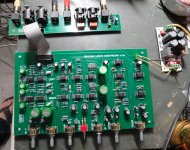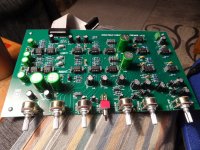When I built mine, I used polar caps for everything except C2, C4, C8 & C16. The only reason I used NP for C8 and C16 is because I didn't have that value in stock so I just ordered what was in the BOM. Mine measures and sounds perfect.
Attachments
Finally got my preamp up and running, works, that's a bonus, but........What's with the volume control? Hardly get it out of the starting gate before I'm deafened!
Had to put a pot on the input to the power amp so I can control it.............
Had to put a pot on the input to the power amp so I can control it.............
Volume attenuation
See #556 to #560 in this thread for a simple cure.
Hope this helps
George
Finally got my preamp up and running, works, that's a bonus, but........What's with the volume control? Hardly get it out of the starting gate before I'm deafened!
Had to put a pot on the input to the power amp so I can control it.............
See #556 to #560 in this thread for a simple cure.
Hope this helps
George
Thank you. It was so over the top that I initially thought one of the channels wasn't working due to the slight imbalance that was magnified by the gain. Glad it's a known issue and not my error. Thanks again
Thank you. It was so over the top that I initially thought one of the channels wasn't working due to the slight imbalance that was magnified by the gain. Glad it's a known issue and not my error. Thanks again
There should be no detectable gain imbalance. I suggest there might be a component error.
Glad to hear you,mr Self!I suppose that,given the high gain of the combination pre+power amp,a slight turn of the volume pot brings one channel to life (and quite loud),whereas the other remains silent.There should be no detectable gain imbalance. I suggest there might be a component error.
Last edited:
Glad to hear you,mr Self!I suppose that,given the high gain of the combination pre+power amp,a slight turn of the volume pot brings one channel to life (and quite loud),whereas the other remains silent.
That should not be happening.
Certainly would not hurt to actually test/measure this channel to channel gain imbalance. All you need is a sine wave signal source and a AC voltmeter (DMM). Use a sine wave for which your DMM can respond to. Many low cost DMM's the ACV function is designed for 50/60Hz AC line and the freq response usually do not not go much over 100Hz. The absolute ACV accuracy is not important, as you are comparing one channel vs the other, so it is a relative measurement.
Glad to hear you,mr Self!I suppose that,given the high gain of the combination pre+power amp,a slight turn of the volume pot brings one channel to life (and quite loud),whereas the other remains silent.
You also might want to check for 'solder bridges' top side of the PCB and under your volume control. You will have to look very closely as it will be mostly out of sight. That easily happens if you get a bit overzealous when soldering the pots in place.
Certainly would not hurt to actually test/measure this channel to channel gain imbalance. All you need is a sine wave signal source and a AC voltmeter (DMM). Use a sine wave for which your DMM can respond to. Many low cost DMM's the ACV function is designed for 50/60Hz AC line and the freq response usually do not not go much over 100Hz. The absolute ACV accuracy is not important, as you are comparing one channel vs the other, so it is a relative measurement.
You can even do a lot just with an ohmmeter. Methodologically check all connections starting at the input to the pot, going from solder point to solder point, checking for continuity as well as shorts to nearby traces. Compare the two channels. Sooner or later you'll hit the culprit.
Jan
Glad to hear you,mr Self!I suppose that,given the high gain of the combination pre+power amp,a slight turn of the volume pot brings one channel to life (and quite loud),whereas the other remains silent.
This is what I found. However, my temporary fix with pot on power amp has bought things back in line. Initially it was impossible to get low level balance. I think the slight disparity at the start of the pot track was enough to get me worried. I will check over anyway and will probably reduce the gain on the volume control section.
I had no volume problems with my build, I followed the original BOM worked perfectly. Sounds great.
My amp is 100K ohms inputt. It sounds a little thin with the Doug, but I surmise in my setup this is because too much ES Muse caps everywhere. Also the 100 uf caps on the power supply pcb I took also needs I surmise a better model (maybe I will try with a Black Gate standard 100 uF or in a different league a Nichicon, but this is just icing on the cake here !) I saw at the beginning of the first pcbs people populated with some Nichicon FW for the biggest values at power position on the main pcb according the pictures (towards the volume pot !). I believe some KG will do better but don't know if the leads will feet in the vias... (spacing ?)
But ihmo all is about the tonal balance of the amp ! Mine is already very clear. (Chord amp)
Tested in single end only for the moment and had no time to tweak yet. I will try Forr member 's tip one day ! I bought 5K Sfernice pot for the volume, but after having heard the stock pots, I believe it's clear and thin enough with carbon pot : no needs for Something more transparent ! I just changed one thing : putted Dale RN55 at the outputt serie résistors... One day will try some noiser carbon Allen Bradley to add a little nice noise !
My has too low hours of use to have an idea about its final sound for the moment. Maybe for the moment my amp is a little too sensible at inputt ! I don't know : haven't had time for it, just boxed it in a wood case.
I bet this pre to play very well with some tube amps with H2 signature...
Forr member towards the beginning of the thread gave advice about a resistor value to help an other member who has also a too much sensible amp and volume pots problems ! But I didn't notice the same problem as you !
cheers
But ihmo all is about the tonal balance of the amp ! Mine is already very clear. (Chord amp)
Tested in single end only for the moment and had no time to tweak yet. I will try Forr member 's tip one day ! I bought 5K Sfernice pot for the volume, but after having heard the stock pots, I believe it's clear and thin enough with carbon pot : no needs for Something more transparent ! I just changed one thing : putted Dale RN55 at the outputt serie résistors... One day will try some noiser carbon Allen Bradley to add a little nice noise !
My has too low hours of use to have an idea about its final sound for the moment. Maybe for the moment my amp is a little too sensible at inputt ! I don't know : haven't had time for it, just boxed it in a wood case.
I bet this pre to play very well with some tube amps with H2 signature...
Forr member towards the beginning of the thread gave advice about a resistor value to help an other member who has also a too much sensible amp and volume pots problems ! But I didn't notice the same problem as you !
cheers
Last edited:
The Latest Batch of PCBs are in ...

The latest batch of PCBs have arrived.
I have built a first article and have bee listening to it for the last 24 hours or so! All works as expected.
Those builders that have paid will be shipped Monday morning (ie: tomorrow).
I do have a few extra kits but not many.

The latest batch of PCBs have arrived.
I have built a first article and have bee listening to it for the last 24 hours or so! All works as expected.
Those builders that have paid will be shipped Monday morning (ie: tomorrow).
I do have a few extra kits but not many.
Last edited:
Really, when???yep and for the coolest, you will have also a metal case at diya store with front marking.
Number Two talked of that before in this thread few pages before (a 1" U case).... (but we don't knwo who is number One...)
https://www.youtube.com/watch?v=fk_CfPEjU10
it's a great mess to try to make the back plate, it will help a lot I believe.
https://www.youtube.com/watch?v=fk_CfPEjU10
it's a great mess to try to make the back plate, it will help a lot I believe.
- Home
- Source & Line
- Analog Line Level
- Doug Self Preamp from Linear Audio #5

